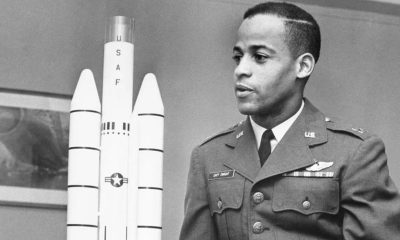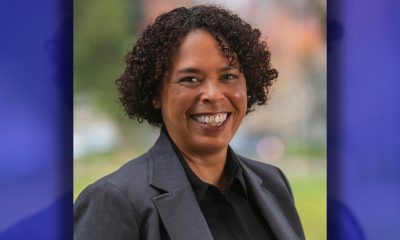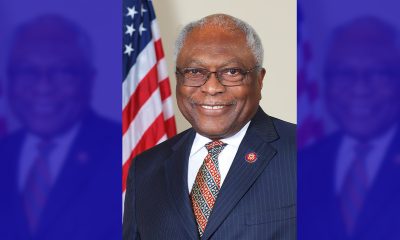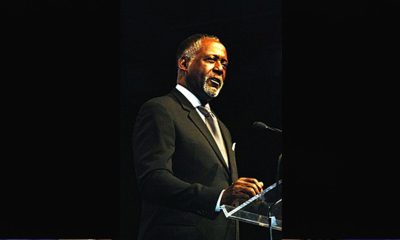Berkeley
War, ‘Mutiny’ and Civil Rights: Remembering Port Chicago
By Barry Bergman, UC Berkeley News
Just after 10:18 p.m. on July 17, 1944, UC Berkeley seismographs measured what looked like a 3.4-magnitude earthquake. Far from a routine temblor, though, this was a seismic event of a different kind: a ferocious explosion at the Port Chicago naval base, the worst stateside disaster of World War II.
The cargo ship E.A. Bryan, docked at the base east of Martinez on the southern bank of the Sacramento, was loaded with 4,000-plus tons of bombs and ammunition, roughly half its capacity, when it lit up the East Bay skies. With the explosive force of five kilotons of TNT, the blast instantly killed 320 men, 202 of them African American, and injured another 390 military personnel and civilians.

A view of the wrecked pier after the explosion at Port Chicago. The submerged stern of the Quinault Victory is visible at upper right. (U.S. Navy photo, courtesy of Robert Allen)
The Quinault Victory, set to start taking on munitions later that night, was also destroyed, along with the base itself and much of the small town of Port Chicago, more than a mile away. The Bryan was so decimated that its wreckage was never recovered. Neither were most of the bodies.
Aftershocks followed. The explosion led to the six-week trial — and dismayingly swift conviction — of 50 Black sailors, whose refusal to return to loading ammunition was judged by the Navy to be mutiny. But Berkeley sociologist Robert Allen, who spent years poring over records and interviewing Port Chicago
survivors, views the “mutiny” as an act of resistance, best understood in the context of other protests by African American servicemen during wartime, and of the nationwide civil-rights movement it foreshadowed.
“What happened there was what was happening to black labor generally — namely, to be segregated into the most demeaning jobs, the hardest jobs, the lowest-paying jobs,” says Allen, whose 1989 book, “The Port Chicago Mutiny,” sparked a resurrection of public interest in a pivotal moment in the history of U.S. race relations. “That was the history of black labor, going back to sharecropping, the Jim Crow system, all of that. These guys were products of that themselves.”
Allen, a soft-spoken Georgia native and recently retired Berkeley adjunct professor, will moderate a panel discussion at a 70th-anniversary symposium July 17 at Diablo Valley College, near the site of the disaster. A second panel at the event, which will feature speakers including historian Leon Litwack, the Pulitzer Prize-winning Berkeley professor emeritus, will be moderated by John Lawrence, a Berkeley Ph.D. and former chief of staff to East Bay congressman George Miller, with whom he has worked for federal recognition and exoneration for the convicted sailors.
Allen himself was unaware of the case until 1976, when he came across a pamphlet written in 1945 by Thurgood Marshall, a future Supreme Court justice, for the NAACP Legal Defense Fund. It began with a question: “Remember Port Chicago?”
Allen read on. The brochure laid out not only the facts of the case, but the broader racial context. All of the roughly 1,400 enlisted men assigned to load ammunition at the base were black, while all the commissioned officers were white. The African American sailors could not become officers, or even transfer laterally to other types of work — including combat, which is why many had volunteered for service in the first place.
“A racially segregated base — here in California,” Allen says, his wonder at the
discovery still evident. “And segregated by federal law at that.” The sailors, he adds, “were basically locked in a prison called Port Chicago Naval Depot.”
And though neither enlisted men nor officers were trained to handle bombs, they faced constant, round-the-clock pressure to ship ammunition from Port Chicago, built in response to Japan’s 1941 attack on Pearl Harbor. The odds of a catastrophic accident were not lost on the men.
After the worst finally happened — an explosion so violent it blew a 440-foot Navy vessel to bits, along with any clues to the accident’s cause — the survivors were understandably fearful of returning to work.
“Keep in mind that half of them are teenagers,” Allen says. “These are kids, terrified of going back to work and getting killed in another explosion.”
Joseph Small, who was 23 when the Bryan blew and respected by most of his younger crewmates, recalled in interviews with Allen how the survivors were expected simply to return to their regular jobs: “The men said, ‘Well, what are you going to do?’ And he said, ‘I’m not going back to the same work under the same conditions under the same officers.’
“That’s the language of a strike. That’s exactly what the stevedores would have said on the waterfront here if they were engaged in a wildcat strike,” Allen says. “But there’s no such thing in the military. And so they get put on trial for mutiny, and for their very lives.”
Labeled a “ringleader,” Small was among the 50 sailors convicted by a panel of admirals. Their defense counsel, a white Navy lieutenant, argued that the men — many of whom acted heroically in the wake of the accident — may have refused to follow orders, but had made no concerted effort to seize command from established military authorities, and so were not guilty of mutiny.
Outside the San Francisco courtroom, meanwhile, Thurgood Marshall was raising broader issues. “This is not 50 men on trial for mutiny,” he declared. “This is the Navy on trial for its whole vicious policy toward Negroes.”
Nonetheless, after barely an hour of deliberation, all 50 men were sentenced to 15 years in prison, to be followed by dishonorable discharge from the Navy. (The end of the war brought their early release.) But they also won a crucial victory.
The notoriety of their plight — which had prompted Eleanor Roosevelt to send a copy of Marshall’s pamphlet to Navy Secretary James Forrestal, with the wish that “in the case of these boys special care will be taken” — led to two white divisions sharing the work of loading ammunition at Port Chicago.
“That’s the very first step in beginning to desegregate the Navy, when they bring in these guys to do the same work that only blacks were doing before,” Allen says
. Over the next year the Navy would permit mixed crews of black and white sailors, though initially limiting black sailors to 10 percent of crews on some auxiliary vessels, and 30 percent at ammunition depots. (The other military branches remained segregated until 1948.)
With the dawn of the postwar era, the explosion and subsequent trial — not to mention their larger significance — were relegated to footnotes in history. “So by the time I was onto it, it was really lost to memory,” Allen says. “And I became interested in trying to find out what had happened.”
It would be 13 years before The Port Chicago Mutiny was completed. Its publication quickly led to an Emmy Award-winning KRON documentary, and then to a spate of other articles, movies and books. (Steve Sheinkin, who recently published a book on the topic for younger readers, is scheduled to speak at Diablo Valley College next week.)
As media attention grew, so did public interest and political efforts to “remember Port Chicago.” Prodded by Lawrence — now a visiting professor at the UC Washington Center — Rep. Miller and others pushed Congress to create the Port Chicago National Memorial at the site of the explosion in 1994, and helped persuade President Clinton to pardon one of the few surviving convicted sailors in 1999.
Yet the Navy has refused to exonerate them, and Allen’s not optimistic about Congress. He’s pinning his hopes on a proclamation by President Obama — and on the spotlight from events like Thursday’s symposium.
Though none of the 50 are still alive, “it would be important to the families to remove this stigma, and it’s important to the nation,” he says. “Because then the nation could say, ‘OK, we understand it. These guys did something that was technically illegal. But they did it in a way that brought about change for the better, just as the civil-rights activists did in the South.’
“The government may not necessarily want to paint them as heroes, but it can no longer paint them as demons,” he adds. “When we look at the process of desegregation in the military, one of its sources is what happened at Port Chicago. We should stop penalizing these sailors for having done something that we now recognize was for the benefit of the country.
“It’s time,” Allen says, “to exonerate these fellows.”
For more details, or to register for the free July 17th event, visit http://portchicagomemorial.org/
Bay Area
Rich Lyons, Longtime Campus Business, Innovation Leader, Will Be UC Berkeley’s Next Chancellor
Rich Lyons, an established economist, former dean of the Haas School of Business and the campus’s current leader for innovation and entrepreneurship, will become the next chancellor at the University of California, Berkeley, the UC Board of Regents announced on April 10.
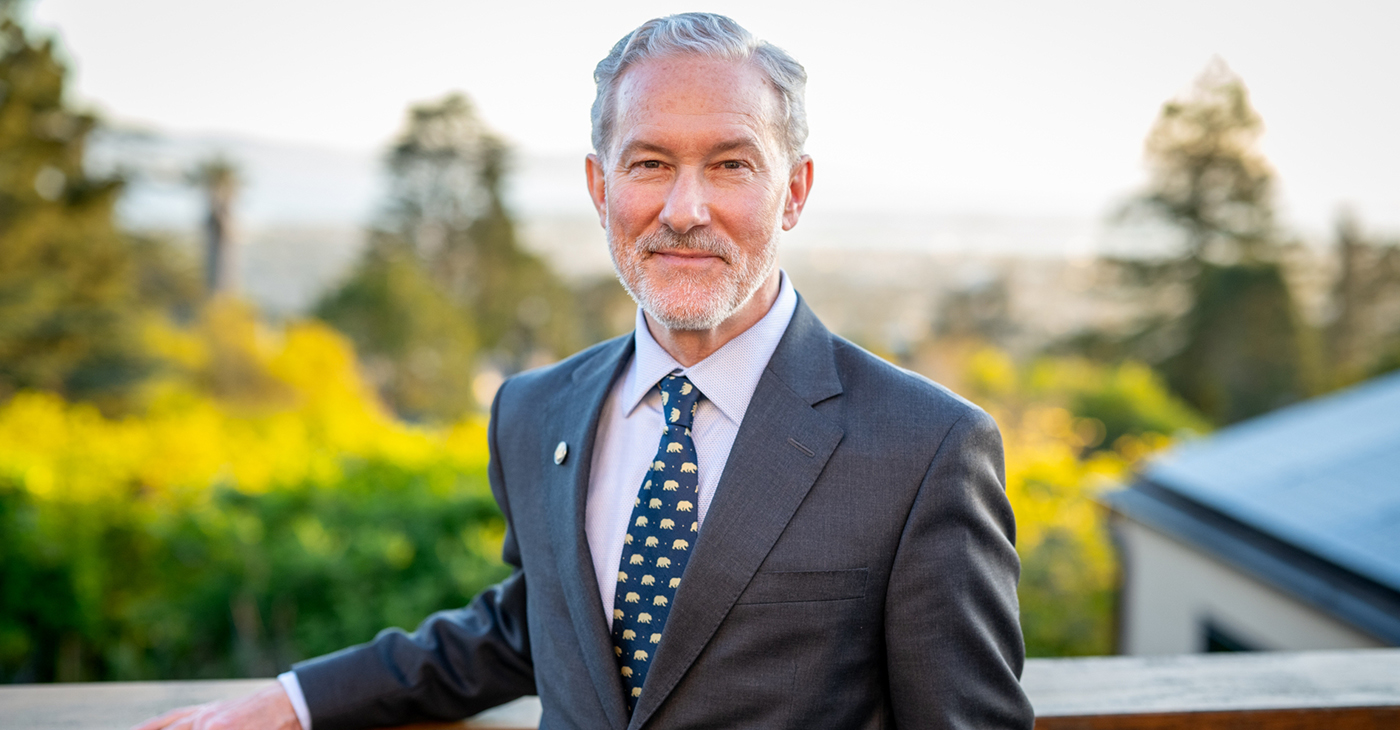
By Jason Pohl
Rich Lyons, an established economist, former dean of the Haas School of Business and the campus’s current leader for innovation and entrepreneurship, will become the next chancellor at the University of California, Berkeley, the UC Board of Regents announced on April 10.
The board’s unanimous confirmation makes Lyons, 63, the first UC Berkeley undergraduate alumnus since 1930 to become the campus’s top leader. In an interview this week, Lyons said he credits his Berkeley roots and his campus mentors with encouraging him to ask big questions, advance institutional culture and enhance public education — all priorities of his for the years to come.
Lyons, who will be Berkeley’s 12th chancellor, will succeed Chancellor Carol Christ, who announced last year that she’d step down as chancellor on July 1.
“I am both thrilled and reassured by this excellent choice. In so many ways, Rich embodies Berkeley’s very best attributes, and his dedication to the university’s public mission and values could not be stronger,” Christ said. “I am confident he will bring to the office visionary aspirations for Berkeley’s future that are informed by, and deeply respectful of, our past.”
Rising through the Berkeley ranks
Born in 1961, Lyons grew up in Los Altos in the early days of the Silicon Valley start-up boom.
He attended Berkeley, where he graduated in 1982 with a Bachelor of Science degree in business and finance. Lyons went on to earn his Ph.D. in 1987 in economics from MIT. After six years teaching at Columbia Business School, Lyons returned west, where in 1993 he joined the Berkeley faculty as a professor of economics and finance, specializing in the study of international finance and global exchange rates.
He’s remained on campus since, with one notable exception.
Starting in 2006, Lyons spent two years working at Goldman Sachs as the chief learning officer. It was a period that instilled in him an appreciation for leadership and the importance of organizational culture.
He carried those lessons with him when he returned to campus in 2008 and became the dean of the Haas School of Business.
While dean, Lyons oversaw the construction of Connie & Kevin Chou Hall, a state-of-the-art academic building that opened in 2017 and is celebrated for its sustainability. He also helped establish two new degree programs, linking the business school with both the College of Engineering and the Department of Molecular and Cell Biology.
But it was his creation of four distinct defining leadership principles that spurred a sweeping culture initiative at the school that stands out in the minds of many. Those values — question the status quo, confidence without attitude, students always, and beyond yourself — became a creed of sorts for new students and alumni alike.
Those values are important, Lyons said, because they shape and support the cohesive structure of a strong, connected community — spanning science and technology to the arts and humanities. They also convey the story about what it means to be at Berkeley and to believe in the university’s public mission.
“When we are great as educators, it’s identity-making,” Lyons said. “We’re helping students and others see identities in themselves that they couldn’t see.”
Lyons in January 2020 became Berkeley’s first-ever chief officer of innovation and entrepreneurship.
Building on his research exploring how leaders drive innovation and set behavioral norms and culture, Lyons worked to expand and champion Berkeley’s rich portfolio of innovation and entrepreneurship activities for the benefit of students, faculty, staff, startups and external partners.
It was a major commitment to thinking outside the box, he said. One need only look to the Berkeley Changemaker program that he helped launch in 2020 to see innovation and entrepreneurship in action.
The campuswide program with some 30 courses tells the story of what Berkeley is — the story that members of the Berkeley community can tell long into the future. Berkeley Changemaker started as an idea and its courses quickly became among the most popular academic offerings on campus.
“Over 500 students showed up,” he said. “Why? Because it’s a narrative. It’s not just a name. It’s not just a curriculum. It’s not just a course. It’s a way of living, and it’s a way of living that Berkeley has occupied forever. This idea that there’s got to be a better way to do this, question the status quo.”
Activism
Oakland’s ‘Green the Church,’ Others, Host a Climate Revival
On April 20, Oakland’s Green The Church California (GTC) and the Center For Food, Faith and Justice will celebrate Earth Day and present a Climate Revival event titled “Growing Healthy Communities From Soil To The Soul” at McGee Avenue Baptist Church at 1640 Stuart St, Berkeley, CA. The day will include inspiring talks, interactive workshops, networking opportunities, and a special panel on Food Sovereignty and Global Food Resilience.

Growing Healthy Communities from Soil to the Soul in Berkeley
By Y’Anad Burrell
On April 20, Oakland’s Green The Church California (GTC) and the Center For Food, Faith and Justice will celebrate Earth Day and present a Climate Revival event titled “Growing Healthy Communities From Soil To The Soul” at McGee Avenue Baptist Church at 1640 Stuart St, Berkeley, CA,
The day will include inspiring talks, interactive workshops, networking opportunities, and a special panel on Food Sovereignty and Global Food Resilience.
The keynote speaker is Rev. Danté R. Quick, PhD, senior pastor of First Baptist Church of Lincoln Gardens in Somerset, N.J. Quick is well known in the Bay Area, having served for more than 10 years as pastor of Friendship Missionary Baptist Church in Vallejo, CA.
Green The Church, founded in 2010 by Rev. Dr. Ambrose Carroll, Sr., and headquartered in Oakland, helps galvanize Black churches and their local communities and leaders to address issues critical to populations historically disengaged from conversations around pollution and health, climate change, and sustainability and energy efficiency.
The organization collaborates with major environmental, sustainability, food security, faith, and community-based non-profit organizations, and is committed to “creation justice”—care and justice for God’s people and the planet—and building the Beloved Community.
Environmental justice has long been a pressing concern for communities of color who bear the brunt of pollution and ecological degradation. Climate change exacerbates these issues, disproportionately impacting vulnerable communities. Recognizing this urgency, Black churches across the country are taking action.
With deep roots in the African American community and its commitment to social justice, the Black Church has become an essential advocate for sustainable practices and policies.
Over the past 14 years, in a powerful collaboration with significant environmental, sustainability, food security, faith, and community-based non-profit organizations, GTC has created a cadre of Black churches engaging in the environmental justice, climate, and sustainability movement.
GTC presently works with more than 1,000 pastors and congregations across the U.S., and groups in the Bahamas, Ghana, Nigeria, and the UK, showing that we can make a difference together.
The partnership between environmental justice advocates and the Black Church extends beyond individual congregations. Green The Church provides resources and support for faith communities seeking to address climate change and promote environmental justice.
Through collaboration, initiatives such as energy efficiency programs, solar installations, and environmental education have been implemented in Black churches nationwide. These efforts reduce the carbon footprint and save money on energy bills, benefiting the congregations and their communities.
The involvement of the Black Church in the fight against climate change is not just a participation, it’s a powerful message that galvanizes action across communities.
By integrating environmental justice into their ministry, Black churches are demonstrating that addressing climate change is not only a matter of science but also of social and moral responsibility, inspiring change at a grassroots level.
For more information, go to: www.greenthechurch.org.
Activism
Who are the Alameda County District 4 Supervisor Candidates’ Top Campaign Contributors?
Below, we’ve listed each candidate’s 10 highest campaign contributors. For Miley, two of his top campaign donors also bought their own advertisements to support him and/or oppose Esteen through independent expenditures. Such expenditures, though separate from campaign donations, are also public record, and we listed them. Additionally, the National Organization of Realtors has spent about $70,500 on their own independent expenditures to support Miley.
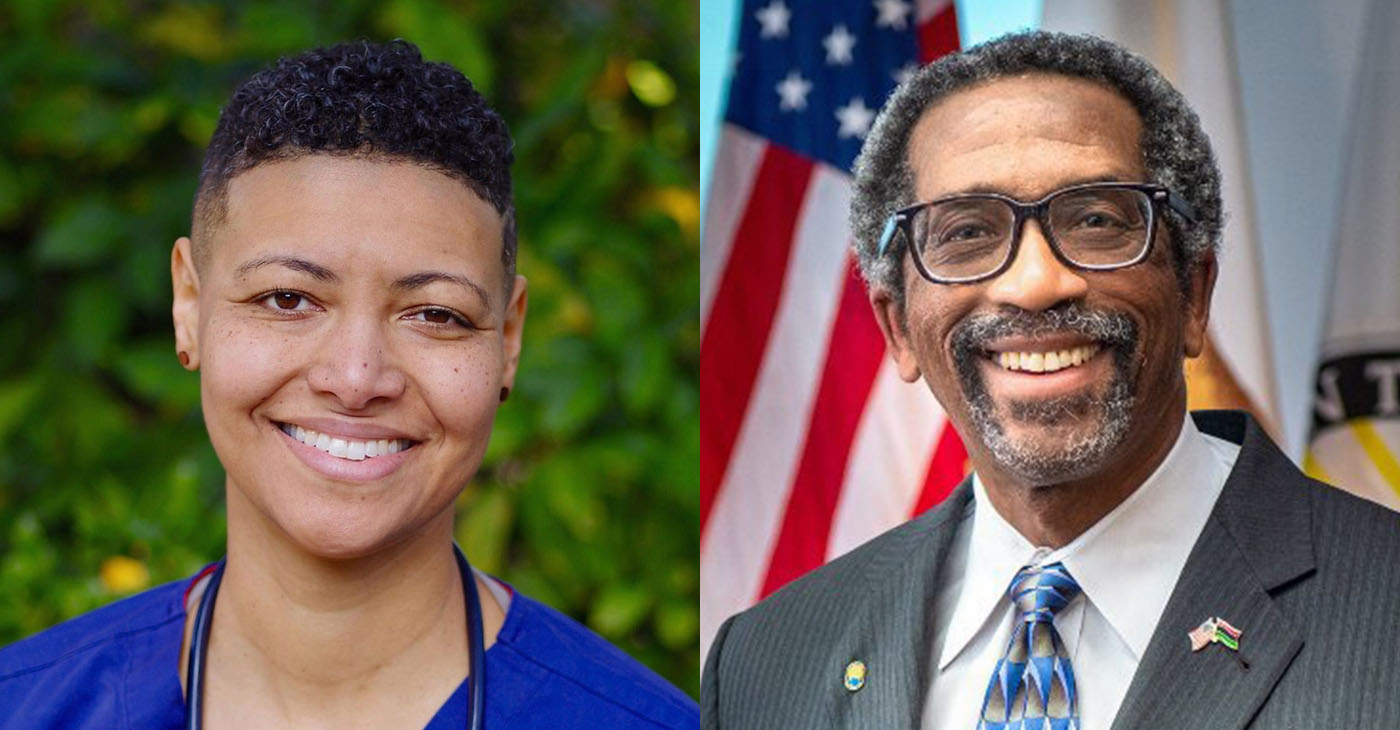
By Zack Haber
Nate Miley, who has served on Alameda County’s Board of Supervisors since 2000, is running for reelection to the District 4 supervisor seat.
Jennifer Esteen, a nurse and activist, is seeking to unseat him and become one of the five members of the powerful board that sets the county’s budget, governs its unincorporated areas, and oversees the sheriff, Alameda Health System, and mental health system.
District 4 includes most of East Oakland’s hills and flatlands beyond Fruitvale, part of Pleasanton and unincorporated areas south of San Leandro like Ashland and Castro Valley.
Voting is open and will remain open until March 5.
In California, campaign donations of $100 or more are public record. The records show that Miley has received about $550,000 in total campaign donations since he won the previous District 4 election in March 2020. Esteen has raised about $255,000 in total campaign donations since she started collecting them last July. All figures are accurate through Feb. 20.
While Miley has raised more money, Esteen has received donations from more sources. Miley received donations of $100 or more from 439 different sources. Esteen received such donations from 507 different sources.
Below, we’ve listed each candidate’s 10 highest campaign contributors. For Miley, two of his top campaign donors also bought their own advertisements to support him and/or oppose Esteen through independent expenditures. Such expenditures, though separate from campaign donations, are also public record, and we listed them. Additionally, the National Organization of Realtors has spent about $70,500 on their own independent expenditures to support Miley.
Nate Miley’s top campaign contributors:
The California Apartment Association, a trade group representing landlords and investors in California’s rental housing business, has spent about $129,500 supporting Miley’s election bid through about $59,500 in ads against Esteen, $55,000 in ads supporting Miley, and $15,000 in campaign donations.
The independent expenditure committee Preserve Agriculture in Alameda County has spent about $46,025 supporting Miley through about $27,200 in their own ads, and $18,825 in donations to his campaign. Preserve Agriculture has supported reelection efforts for former Alameda County DA Nancy O’Malley, and Sheriff Greg Ahern, a republican. It’s received funding from Chevron, PG&E, and a the California Apartment Association.
Organizations associated with the Laborers’ International Union of North America, or LiUNA, have donated about $35,000 in total. Construction and General Laborers Local 304, a local chapter of the union representing which represents over 4,000 workers, donated $20,000.
Laborers Pacific Southwest Regional Organizing Coalition, which represents 70,000 LiUNA members in Arizona, California, Hawaii and New Mexico, donated $15,000.
William ‘Bill’ Crotinger and the East Oakland-based company Argent Materials have donated $26,000. Crotinger is the president and founder of Argent, a concrete and asphalt recycling yard. Argent’s website says it is an eco-friendly company that diverts materials from landfills. In 2018, Argent paid the EPA $27,000 under a settlement for committing Clean Water Act violations.
Michael Morgan of Hayward, owner of We Are Hemp, a marijuana dispensary in Ashland, has donated $21,500.
Alameda County District 1 Supervisor David Haubert has donated $21,250 from his 2024 reelection campaign. He’s running unopposed for the District 1 seat.
SEIU 1021, which represents over 60,000 workers in local governments, non-profit agencies, healthcare programs, and schools in Northern California, has donated $20,000.
UA Local 342, which represents around 4,000 pipe trades industry workers in Contra Costa and Alameda counties, donated $20,000.
The union representing the county’s deputy sheriffs, Deputy Sheriff’s Association of Alameda County, has donated $17,000.
Becton Healthcare Resources and its managers have donated $14,625. Becton’s mission statement says it provides “behavioral health management services to organizations and groups that serve the serious and persistent mentally ill population.”
Jennifer Esteen’s top campaign contributors:
Mary Quinn Delaney of Piedmont, founder of Akonadi Foundation, has donated $20,000. Akonadi Foundation gives grants to nonprofit organizations, especially focusing on racial justice organizing,
Bridget Galli of Castro Valley has donated $7,000. Galli is a yoga instructor and a co-owner of Castro Valley Yoga.
Rachel Gelman of Oakland has donated $5,000. Gelman is an activist who has vowed to redistribute her inherited wealth to working class, Indigenous and Black communities.
California Worker Families Party has donated $5,000. The organization’s website describes itself as a “grassroots party for the multiracial working class.”
David Stern of Albany has donated $5,000. Stern is a retired UC Berkeley Professor of Education.
Oakland Rising Committee—a collaborative of racial, economic, and environmental justice organizations—has donated about $3,050.
Fredeke Von Bothmer-Goodyear, an unemployed resident of San Francisco, has donated $2,600.
Robert Britton of Castro Valley has donated $2,500. Britton is retired and worked in the labor movement for decades.
Progressive Era PAC has donated about $2,400. Its mission statement says it “exists to elect governing majorities of leaders in California committed to building a progressive era for people of color.”
East Bay Stonewall Democrats Club has donated $2,250. The club was founded in 1982 to give voice to the East Bay LGBTQIA+ communities.
-

 Activism4 weeks ago
Activism4 weeks agoOakland Post: Week of March 20 – 26, 2024
-

 #NNPA BlackPress3 weeks ago
#NNPA BlackPress3 weeks agoCOMMENTARY: D.C. Crime Bill Fails to Address Root Causes of Violence and Incarceration
-

 #NNPA BlackPress3 weeks ago
#NNPA BlackPress3 weeks agoMayor, City Council President React to May 31 Closing of Birmingham-Southern College
-

 #NNPA BlackPress4 weeks ago
#NNPA BlackPress4 weeks agoCOMMENTARY: Lady Day and The Lights!
-

 #NNPA BlackPress3 weeks ago
#NNPA BlackPress3 weeks agoFrom Raids to Revelations: The Dark Turn in Sean ‘Diddy’ Combs’ Saga
-

 #NNPA BlackPress4 weeks ago
#NNPA BlackPress4 weeks agoBaltimore Key Bridge Catastrophe: A City’s Heartbreak and a Nation’s Alarm
-

 Activism3 weeks ago
Activism3 weeks agoOakland Post: Week of March 27 – April 2, 2024
-

 #NNPA BlackPress3 weeks ago
#NNPA BlackPress3 weeks agoBaltimore’s Key Bridge Struck by Ship, Collapses into Water




